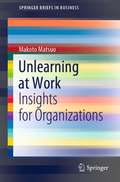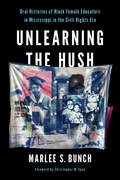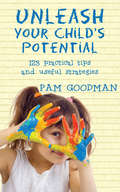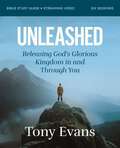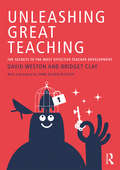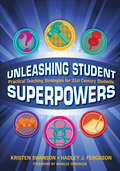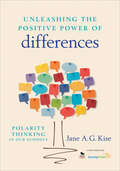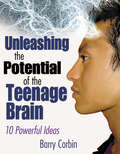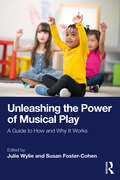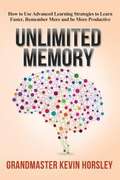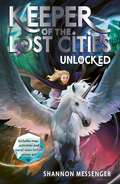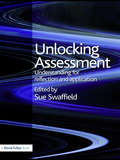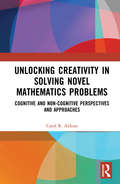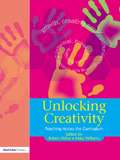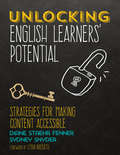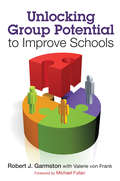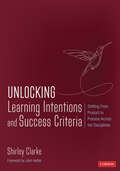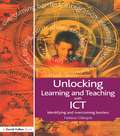- Table View
- List View
Unlearning at Work: Insights for Organizations (SpringerBriefs in Business)
by Makoto MatsuoThis book is to provide insights into the process of individual unlearning, which is little known in previous studies. This is the first book that described how employees should unlearn, i.e., abandon obsolete and outdated beliefs or routines to acquire new ones, at workplace. Updating old knowledge and skills to new one is crucial not only for organizations but also for individuals to survive in today’s competitive and turbulent environment. It provides readers with mechanisms by which personal factors, such as goal orientation, reflection, and critical reflection, and promotes employees’ unlearning under the influence of situational factors such as supervisors’ behaviors and promotion of the positions. Based on the findings by quantitative and qualitative analyses using questionnaire survey and interviews, this book is highly recommended to readers who are interested in higher-order learning process for self-change at work in the fields of organizational behavior and human resources development.
Unlearning the Hush: Oral Histories of Black Female Educators in Mississippi in the Civil Rights Era (Transformations: Womanist studies)
by Marlee S. BunchDespite significant challenges and historical opposition, Black female teachers stood at the forefront of advocating for and providing education to Black students. Their dedication not only improved opportunities for Black communities but also influenced changes in U.S. laws and societal expectations. Marlee S. Bunch draws on oral histories to illuminate the interior lives of Black female educators who taught before and after desegregation in Hattiesburg, Mississippi. In their own voices, these women detail the hurdles they faced guiding students through Jim Crow laws and Civil Rights–era desegregation. Bunch unearths the personal stories of teaching and activism during a historic time that included the Brown v. Board of Education decision and whites’ massive resistance to desegregation. The educators highlight the significance of the Black community and the role of Black homes in fostering student success and community cohesion. In addition, Bunch looks at the legacies of Black educators and the work still to be done. Visual artwork and poetry complement the text. Inspiring and immersive, Unlearning the Hush blends personal memory with Civil Rights history to document the pivotal role Black women played in education during a transformative and charged period in American history.
Unleash Your Child's Potential: 123 practical tips and useful strategies
by Pam GoodmanUnleash your child's true learning potential with this powerful and practical go-to guide. Learn how to supplement traditional teaching done at school with proven, easy to apply tips and strategies tuned to the specific ways your child learns and processes information. By following Pam's strategies, your child will find that learning is fun when it make sense.This guide is packed with over 14 years of hands-on experience. By adopting the strategies presented, you'll enjoy watching your child blossom into a confident, successful, and independent student.
Unleashed Bible Study Guide plus Streaming Video: Releasing God's Glorious Kingdom in and Through You
by Dr. Tony EvansLearn how to boldly represent God's kingdom in your everyday life and be challenged to embrace your role as an ambassador for Christ.Are you ready to experience God's power in every area of your life? Break free from frustration, defeat, and spiritual stagnation with this Bible study, Unleashed, by Dr. Tony Evans. You'll learn how to live under God's kingdom authority and unlock the power, purpose, and peace He's already made available to you. You are called to represent God's kingdom here on earth through your words, actions, and faith.In this study you will learn how to:Activate the Holy Spirit's power to overcome obstacles and live confidentlyDeepen your understanding of Scripture and align your faith with God's truthEmbrace your identity in God's kingdom as you live out your faithPerfect for individual study, small groups, or in a church setting, Unleashed is packed with biblical insights, practical steps, and inspiring stories to help you live the life God created you for.You'll experience God like never before and see Him release His power in your life. Get ready to be unleashed!This study guide has everything you need for a full Bible study experience, including:Video notes and comprehensive structure for group discussion timePersonal study for deeper reflection between sessionsA guide to best practices for leading a groupAn individual access code to stream all video sessions online. (You don't need to buy a DVD!)Streaming video access included. Access code subject to expiration after 12/31/2030. Code may be redeemed only by the recipient of this package. Code may not be transferred or sold separately from this package. Internet connection required. Void where prohibited, taxed, or restricted by law. Additional offer details inside.
Unleashing Children’s Voices in New Democratic Primary Education (Unlocking Research)
by Julia Flutter James Biddulph Luke RollsAs the world begins to emerge from the COVID-19 pandemic and grapples to find ways to respond to climate change, there is growing recognition of the need to give space and time in primary schools to hear children’s experiences, ideas and perspectives on these matters and to promote their active participation in democratic solutions. This book presents vibrant examples from professional educators and researchers across the globe who are demonstrating how primary schools can nurture the conditions for new democratic education through empowering educators’ and children’s voices and agency. Written as a genuine partnership between research experts and experienced classroom teachers, the book delves into historic and contemporary theories and evidence about the children’s voices movement, and new democratic education, helping to root teachers’ practices to strong educational theoretical concepts. The second section presents a set of diverse and detailed examples drawn from primary classrooms and schools that illustrate how these ideas are taking shape in teaching and learning across the world; chapters will bring to life the principles upon which schools have empowered young voices, sharing examples of success and thriving students. Finally, a set of thought-provoking manifestos will offer new opportunities and fresh theories for educators to explore, with the purpose and intention to take forward in their own primary school contexts. This is a vital resource for any new or experienced teacher or school leader looking to take research-informed and principled approaches to changes in schools so that teaching and learning ignites the social imagination for 21st-century educators and learners.
Unleashing Great Teaching: The Secrets to the Most Effective Teacher Development
by David Weston Bridget ClayIt’s within the power of each and every school to unleash the best in teachers, day by day, month by month, year by year. This practical handbook takes the guesswork out of professional learning, showing school leaders how they can build a self-improving culture and remove barriers to learning. David Weston and Bridget Clay set out their advice for how every school can bring in the best ideas from the whole system, and make sure that these have a lasting effect in the classroom. Packed full of examples, easy-to-use ideas and checklists, Unleashing Great Teaching brings together a vast body of experience gained by the Teacher Development Trust (UK), and shows how other schools can learn from these insights. From fostering a culture of evaluating impact to establishing good relationships, communication and a developmental culture, this book takes each and every aspect of the school system and reassesses its role as a driver of teacher and student success. An invaluable resource for leaders at any level within the schooling system, Unleashing Great Teaching will open doors and inspire leaders, teachers, students and communities to learn about learning.
Unleashing Greatness – a strategy for school improvement
by David HopkinsThere is a paradox at the heart of contemporary school improvement and system change in education. Why is it that despite the phenomenal increase in our recent knowledge about what works in schooling, standards still lag behind expectations and school level performance is far too variable? Unleashing Greatness addresses this paradox and concludes that, unless we focus unrelentingly on the quality of teaching in both our small and large-scale reform efforts, current practice will never meet society's expectations.Unleashing Greatness is a compilation of David Hopkins' writing into one concise manual to provide an eight-step strategy for unleashing greatness. Introducing a rational and conceptual framework for pedagogic improvement that has the potential for generating an increasingly specific language for teaching and learning, this book significantly aids consistency and precision in the quest for both excellence and equity for all students.Written for 'school improvement activists', particularly those who work in laboratory schools or who wish to emulate that ethos and way of working, the author himself has located his professional practice for over forty years, as well as this book, in the middle of that triangle bounded by the vertices of practice, research and policy.
Unleashing Greatness – a strategy for school improvement
by David HopkinsThere is a paradox at the heart of contemporary school improvement and system change in education. Why is it that despite the phenomenal increase in our recent knowledge about what works in schooling, standards still lag behind expectations and school level performance is far too variable? Unleashing Greatness addresses this paradox and concludes that, unless we focus unrelentingly on the quality of teaching in both our small and large-scale reform efforts, current practice will never meet society's expectations.Unleashing Greatness is a compilation of David Hopkins' writing into one concise manual to provide an eight-step strategy for unleashing greatness. Introducing a rational and conceptual framework for pedagogic improvement that has the potential for generating an increasingly specific language for teaching and learning, this book significantly aids consistency and precision in the quest for both excellence and equity for all students.Written for 'school improvement activists', particularly those who work in laboratory schools or who wish to emulate that ethos and way of working, the author himself has located his professional practice for over forty years, as well as this book, in the middle of that triangle bounded by the vertices of practice, research and policy.
Unleashing Student Superpowers: Practical Teaching Strategies for 21st Century Students
by Kristen N. Swanson Hadley J. FergusonTurn students into learning superheroes! Like we see in the movies, no two superheroes learn to use their powers in the exact same way. Each of your students has superpowers hidden inside, and you hold the keys to unlock them. With this cutting-edge handbook, you’ll turn your classroom into a place where students don’t just receive an education—they use their powers to create it. Discover specific, ready-to-use instructional journeys designed to foster an inquiry-based, student-driven learning environment. Each research-based journey Supports one of the six student superpowers: Wondering, Curating, Designing, Digital Inking, Gaming, and Connecting Encourages students to think deeply; as required by the CCSS and NGSS Includes step-by-step lesson frameworks, aligned with the Common Core, that fit into your regular day Tear through the obstacles of achievement and show your students that anything is possible! "Ferguson and Swanson explain why tapping into student competencies is imperative and show the road-map for matching engaging activities to specific standards. So many books on the market explain why a shift is needed; this one gives you the tools to do it." —Erin Klein, Teacher Michigan Reading Association, Bloomfield Hills "Unleashing Student Superpowers is an amazing resource for the creation and enhancement of student-centered classroom environments that focus on high-level questioning, inquiry, and passion-based learning. Each Superpower theme provides linkages to the Common Core and flexible lesson plans that promote relevant skills for students’ learning." —Victoria Olson, Teacher West Langley Elementary School, Canada
Unleashing Student Superpowers: Practical Teaching Strategies for 21st Century Students
by Kristen N. Swanson Hadley J. FergusonTurn students into learning superheroes! Like we see in the movies, no two superheroes learn to use their powers in the exact same way. Each of your students has superpowers hidden inside, and you hold the keys to unlock them. With this cutting-edge handbook, you’ll turn your classroom into a place where students don’t just receive an education—they use their powers to create it. Discover specific, ready-to-use instructional journeys designed to foster an inquiry-based, student-driven learning environment. Each research-based journey Supports one of the six student superpowers: Wondering, Curating, Designing, Digital Inking, Gaming, and Connecting Encourages students to think deeply; as required by the CCSS and NGSS Includes step-by-step lesson frameworks, aligned with the Common Core, that fit into your regular day Tear through the obstacles of achievement and show your students that anything is possible! "Ferguson and Swanson explain why tapping into student competencies is imperative and show the road-map for matching engaging activities to specific standards. So many books on the market explain why a shift is needed; this one gives you the tools to do it." —Erin Klein, Teacher Michigan Reading Association, Bloomfield Hills "Unleashing Student Superpowers is an amazing resource for the creation and enhancement of student-centered classroom environments that focus on high-level questioning, inquiry, and passion-based learning. Each Superpower theme provides linkages to the Common Core and flexible lesson plans that promote relevant skills for students’ learning." —Victoria Olson, Teacher West Langley Elementary School, Canada
Unleashing the Positive Power of Differences: Polarity Thinking in Our Schools
by Jane A. KiseMove from entrenched differences to common goals! All too often, key education initiatives collapse because leaders fail to anticipate and learn from the concerns of those charged with implementation. This illuminating book shows how education leaders can bring opposing groups to common ground, resulting in a solid plan built on diverse wisdom. Acclaimed education coach Jane Kise demonstrates how polarity thinking—a powerful tool for bridging differences developed by Barry Johnson of Polarity Partnerships—provides an alternative to endless debates and either/or thinking. Rather than seeing conflicting forces, the tools help us view them as equally important—even interdependent—concepts, approaches, or models. Readers will find: Ways to recognize polarities, map the positive and negative aspects, and channel energy wasted on disagreement toward a greater common purpose Tools for introducing and working with polarities Polarity mapping to help leaders improve processes for leading change and creating buy-in Ways to use polarity with students as a framework for higher-level thinking "Jane Kise provides guidance for educators engaged in deep change and implementation of initiatives in which stakeholders have opposing perspectives. Through authentic examples of significant changes educators face today, Kise guides educators to leverage polarity thinking to promote commitment, engagement, and investment." — Joellen Killion, Senior Advisor Learning Forward "The mind, entrenched in the rigidity of either/or thinking, dwells on the divisions and ignores the connections of both/and. This engaging and practical book helps our students (and their teachers) transcend those divisions in a journey toward enriched enlightenment and greater flexibility." —Arthur L. Costa, Emeritus Professor California State University, Sacramento
Unleashing the Potential of the Teenage Brain: Ten Powerful Ideas
by Barry Doran CorbinProvides teachers with specific guidelines to establish an optimal learning environment for teenagers and offers case studies that illustrate how to translate theory into workable classroom practice.
Unleashing the Power of Musical Play: A Guide to How and Why It Works
by Susan Foster-Cohen Julie WylieRich in practical insights and personal reflections from teachers and therapists, this book explains what musical play is, how and why it benefits children, and how it can be integrated into educational, community and clinical environments.Wylie and Foster-Cohen explore the importance of musical play to human development and human relationships within families, in schools and in therapeutic contexts. The chapters address the evidence base of musical play, its value and use in therapeutic contexts, the roles of musical play in different cultures, and how musical play can enrich communities. Taking a holistic view, it highlights the role of musical play in cultural sustainability, human justice, and community well-being. The book supports learning through a broad range of practical examples of musical play in diverse settings around the world. The chapters are complemented by personal reflections from families, teachers, therapists and other professionals from around the world, who share their skills and experiences embracing musical play with the children in their care. Engaging and accessible, even to those with little or no musical training, this book is an essential resource for pre- and in-service educators, as well as professionals in therapeutic fields, eager to learn more about how musical play can enhance the education and well-being of young people.
Unlikely Allies in the Academy: Women of Color and White Women in Conversation
by Karen L. DaceA CHOICE Outstanding Academic Title 2012! Unlikely Allies in the Academy brings the voices of women of Color and White women together for much-overdue conversations about race. These well-known contributors use narrative to expose their stories, which are at times messy and always candid. However, the contributors work through the discomfort, confusion, and frustration in order to have honest conversations about race and racism. The narratives from Chicanas, Indigenous, Asian American, African American, and White women academicians explore our past, present, and future, what separates us, and how to communicate honestly in an effort to become allies. Chapters discuss the need to interrupt and disrupt the norms of interaction and engagement by allowing for the messiness of discomfort in frank discussion. The dialogues model how to engage in difficult dialogues about race and begin to illuminate the unspoken misunderstandings about how White women and women of Color engage one another. This valuable book offers strategies, ideas, and the hope for moving toward true alliances in the academy and to improve race relations. This important resource is for Higher Education administrators, faculty, and scholars grappling with the intersectionality of race and gender as they work to understand, study, and create more inclusive climates.
Unlimited Memory: How to Use Advanced Learning Strategies to Learn Faster, Remember More and Be More Productive
by Kevin HorsleyIn Unlimited Memory, you'll learn how the world's best memory masters get themselves to concentrate at will, anytime they want. When you can easily focus and concentrate on the task at hand, and store and recall useful information, you can easily double your productivity and eliminate wasted time, stress and mistakes at work. In this book, you'll find all the tools, strategies and techniques you need to improve your memory.
Unlocked 8.5 (Keeper of the Lost Cities)
by Shannon MessengerBook 8.5 in the New York Times bestselling Keeper of the Lost Cities series delivers what fans have been begging for! Told in an exciting new way, the saga continues with plenty of huge reveals and shocking new twists – plus a complete series guide with beautiful colour and black-and-white illustrations and other awesome bonuses, never seen before in the UK! In this extra special installment of the Keeper of the Lost Cities series, the story picks up right from Legacy&’s particularly devastating cliffhanger. But chapters alternate between Sophie and Keefe&’s perspectives to give readers deeper insights into both beloved characters. New powers will be discovered. Hard truths from the past will come to light. And all of your favorite characters will find themselves tested in ways they never imagined.And that's not all!Unlocked also includes a comprehensive guide to the world of the Lost Cities, featuring new character and world details that have never been revealed before – plus fun bonuses like Keeper-themed recipes, a detailed map of the Lost Cities, gorgeous full-color illustrations, and so much more!Also in the Keeper of the Lost Cities series:Keeper of the Lost Cities Exile Everblaze Neverseen Lodestar Nightfall Flashback Legacy
Unlocking Assessment: Understanding for Reflection and Application
by Sue SwaffieldAssessment is inextricably linked with learning and teaching, and its profile in British schools has never been higher. Recently the value and importance of formative assessment in supporting learning and teaching has also become widely recognised. Although assessment is a prime concern of anyone involved in education it remains a highly complex field where much controversy and misunderstanding abounds. This book explores the values, principles, research and theories that underpin our understanding and practice of assessment. It also provides practical suggestions and examples, and addresses some key points about the future development of assessment. The book makes accessible complex but crucial ideas and issues, so that teachers can be more confident and proactive in shaping assessment in their classrooms, in ways that support learning and avoid unintentional harmful consequences.
Unlocking Creativity in Solving Novel Mathematics Problems: Cognitive and Non-Cognitive Perspectives and Approaches
by Carol R. AldousUnlocking Creativity in Solving Novel Mathematics Problems delivers a fascinating insight into thinking and feeling approaches used in creative problem solving and explores whether attending to ‘feeling’ makes any difference to solving novel problems successfully. With a focus on research throughout, this book reveals ways of identifying, describing and measuring ‘feeling’ (or ‘intuition’) in problem-solving processes. It details construction of a new creative problem-solving conceptual framework using cognitive and non-cognitive elements, including the brain’s visuo-spatial and linguistic circuits, conscious and non-conscious mental activity, and the generation of feeling in listening to the self, identified from verbal data. This framework becomes the process model for developing a comprehensive quantitative model of creative problem solving incorporating the Person, Product, Process and Environment dimensions of creativity. In a world constantly seeking new ideas and new approaches to solving complex problems, the application of this book’s findings will revolutionize the way students, teachers, businesses and industries approach novel problem solving, and mathematics learning and teaching.
Unlocking Creativity: A Teacher's Guide to Creativity Across the Curriculum (Unlocking Series)
by Mary Williams Robert FisherShowing how creativity can be developed across the curriculum, this book offers advice on how to develop children's capacity for creative thinking and achievement and use creativity to increase levels of motivation and self-esteem. Combining the latest research with practical ideas and tasks, this multidimensional book is a must for teachers, students, and educators who wish to know more about creativity in teaching and learning.
Unlocking English Learners' Potential: Strategies for Making Content Accessible
by Diane Staehr Fenner Sydney C. Snyder“Schools are not intentionally equitable places for English learners to achieve, but they could be if the right system of support were put in place. Diane Staehr Fenner and Sydney Snyder recommend just such a system. Not only does it have significant potential for providing fuller access to the core curriculum, it also provides a path for teachers to travel as they navigate the individual needs of students and support their learning journeys.” —Douglas Fisher, Coauthor of Visible Learning for Literacy A once-in-a-generation text for assisting a new generation of students Content teachers and ESOL teachers, take special note: if you’re looking for a single resource to help your English learners meet the same challenging content standards as their English-proficient peers, your search is complete. Just dip into this toolbox of strategies, examples, templates, and activities from EL authorities Diane Staehr Fenner and Sydney Snyder. The best part? Unlocking English Learners’ Potential supports teachers across all levels of experience. The question is not if English learners can succeed in today’s more rigorous classrooms, but how. Unlocking English Learners’ Potential is all about the how: How to scaffold ELs’ instruction across content and grade levels How to promote ELs’ oral language development and academic language How to help ELs analyze text through close reading and text-dependent questions How to build ELs’ background knowledge How to design and use formative assessment with ELs Along the way, you’ll build the collaboration, advocacy, and leadership skills that we all need if we’re to fully support our English learners. After all, any one of us with at least one student acquiring English is now a teacher of ELs.
Unlocking English Learners' Potential: Strategies for Making Content Accessible
by Diane Staehr Fenner Sydney C. Snyder“Schools are not intentionally equitable places for English learners to achieve, but they could be if the right system of support were put in place. Diane Staehr Fenner and Sydney Snyder recommend just such a system. Not only does it have significant potential for providing fuller access to the core curriculum, it also provides a path for teachers to travel as they navigate the individual needs of students and support their learning journeys.” —Douglas Fisher, Coauthor of Visible Learning for Literacy A once-in-a-generation text for assisting a new generation of students Content teachers and ESOL teachers, take special note: if you’re looking for a single resource to help your English learners meet the same challenging content standards as their English-proficient peers, your search is complete. Just dip into this toolbox of strategies, examples, templates, and activities from EL authorities Diane Staehr Fenner and Sydney Snyder. The best part? Unlocking English Learners’ Potential supports teachers across all levels of experience. The question is not if English learners can succeed in today’s more rigorous classrooms, but how. Unlocking English Learners’ Potential is all about the how: How to scaffold ELs’ instruction across content and grade levels How to promote ELs’ oral language development and academic language How to help ELs analyze text through close reading and text-dependent questions How to build ELs’ background knowledge How to design and use formative assessment with ELs Along the way, you’ll build the collaboration, advocacy, and leadership skills that we all need if we’re to fully support our English learners. After all, any one of us with at least one student acquiring English is now a teacher of ELs.
Unlocking Group Potential to Improve Schools
by Robert J. Garmston Valerie Von FrankHow great groups make great schools This field book shows educators how to develop group culture, enhance facilitators’ skills, and optimize the group’s most precious resource—its members. The authors describe how to form working committees, task forces, grade-level, and department teams, and faculties that are more effective and better equipped to resolve complex issues around student learning. Specific topics include: Understanding eight principles that underlie effective groups Learning the five standards for effective meetings Setting clear goals and roles Practicing new ways of talking for improved collaboration Examining perceptions and mental models Enhancing energy sources Working with conflict Developing basic facilitation skills
Unlocking Learning Intentions and Success Criteria: Shifting From Product to Process Across the Disciplines
by Shirley ClarkeThe expert’s guide to making LISC work for you! In over twenty years of research, Shirley Clarke has found that the key to understanding, creating, and implementing LISC is to focus on the process of learning rather than the product, or end result. In this practical guide, she shows you: · How to phrase learning intentions, organize and plan for them, and share them with students · How to create success criteria to fit each learning intention · How to adapt these practices to different disciplines—with examples · Implementation strategies based on real-life teacher success stories
Unlocking Learning Intentions and Success Criteria: Shifting From Product to Process Across the Disciplines
by Shirley ClarkeThe expert’s guide to making LISC work for you! In over twenty years of research, Shirley Clarke has found that the key to understanding, creating, and implementing LISC is to focus on the process of learning rather than the product, or end result. In this practical guide, she shows you: · How to phrase learning intentions, organize and plan for them, and share them with students · How to create success criteria to fit each learning intention · How to adapt these practices to different disciplines—with examples · Implementation strategies based on real-life teacher success stories
Unlocking Learning and Teaching with ICT: Identifying and Overcoming Barriers (Unlocking Series)
by Helena GillespieBy clearly identifying the barriers that can still exist to the successful integration of ICT in schools this book aims to suggest ways in which these barriers may be overcome. Current and past policy and practice is examined and where barriers are identified, the book: provides suggested strategies for the removal of these barriers recommends how to avoid the obstacles in the first place includes action points and ideas to provide ways forward uses case studies and vignettes to focus on the positive benefits of ICT. Optimistic and forward-looking, the book also explores how ICT, when effectively used, can help children learn and achieve to the best of their abilities. It is relevant for trainee and practising teachers, ICT co-ordinators and school managers in all key stages.
